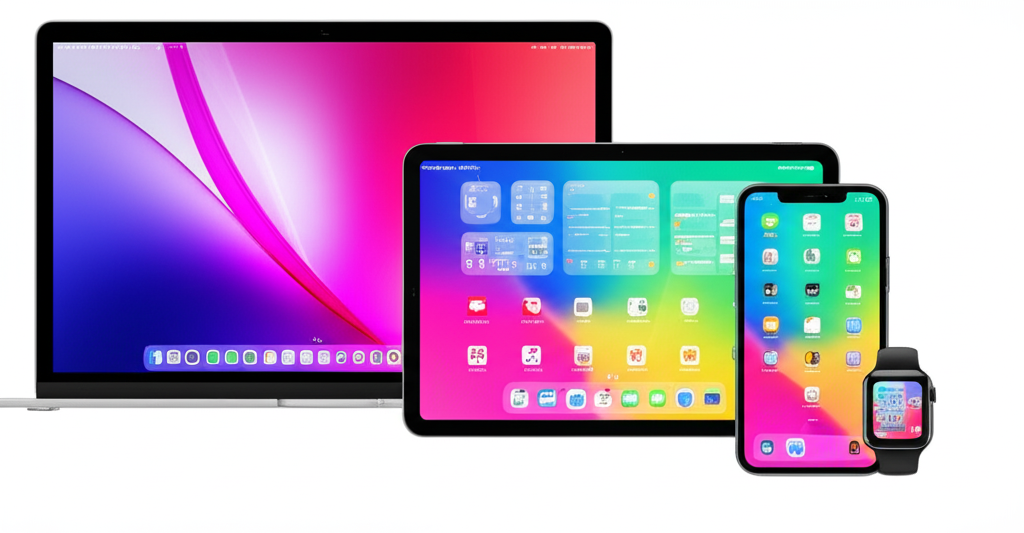
Apple has long been synonymous with innovation, from the introduction of the iPhone in 2007 to the transformative jump to Apple Silicon. Now, with the upcoming release of iOS 26, Apple is reportedly preparing to once again rewrite the rules of mobile technology—this time with the integration of liquid glass technology.
If the leaks and industry whispers prove true, iOS 26 could mark the beginning of a new era in smartphone design—one where adaptive, self-healing displays, ultra-durability, and next-gen touch interfaces meet intelligent software designed to take full advantage of a reimagined screen surface. Here’s a deep dive into what we know, what we expect, and how liquid glass might change everything.
What is Liquid Glass?
Before we explore iOS 26, it’s essential to understand liquid glass—a cutting-edge material that could become a foundation for future devices. Liquid glass is made from silicon dioxide (SiO₂), the primary compound in glass, suspended in liquid form. When applied as a coating, it forms an invisible nano-thin protective layer that bonds at the molecular level with the surface it coats.
Key Features of Liquid Glass:
- Self-healing properties: It can “heal” minor scratches and abrasions over time.
- Water & dust repellency: The coating creates a hydrophobic barrier, keeping moisture and dirt at bay.
- High durability: It increases resistance to scratches, cracks, and shattering.
- Enhanced touch sensitivity: Thinner and smoother than traditional glass protectors, allowing more accurate haptic feedback.
- Antimicrobial surface: Naturally resists the growth of bacteria and germs.
Until recently, liquid glass was used primarily as a screen protector alternative. However, breakthroughs in materials science may now allow Apple and other manufacturers to embed liquid glass at a structural level, potentially creating devices that are thinner, more durable, and more interactive than ever before.
The Leap to iOS 26
Apple’s operating systems are designed in harmony with its hardware, and if liquid glass becomes a key feature of upcoming devices like the iPhone 17 or a potential iPhone Fold, iOS 26 will almost certainly be engineered to complement it.
Here are some of the key changes and enhancements we expect in iOS 26—especially in relation to this futuristic hardware upgrade.
1. Dynamic Display UI
iOS 26 is expected to introduce a new layer of UI adaptability that responds to the device’s shape and the user’s interaction. Imagine an iPhone that bends slightly when watching a video or a folded iPad that changes its app layout dynamically. With liquid glass providing a more flexible screen structure, Apple could usher in an entirely fluid interface, enabling:
- Auto-shifting control panels when gripping or folding the phone
- Content resizing based on angle or tilt
- Immersive, full-screen experiences that feel tactile and alive
This would take Apple’s existing Dynamic Island and Live Activities concepts even further, expanding how the user interacts with the screen.
2. Next-Gen Touch and Gesture Support
The ultra-smooth surface and adaptive flexibility of liquid glass pave the way for advanced gesture controls. With iOS 26, Apple may introduce:
- 360-degree gesture tracking, allowing for air gestures or edge-based swipes
- Pressure zones that detect subtle taps, presses, and squeezes
- Enhanced haptic feedback that adapts to finger position and screen curvature
This would align well with Apple’s growing focus on accessibility and custom control schemes, offering a more personalized experience for every user.
3. Deeper AI Integration with VisionOS Crossover
iOS 26 is expected to deepen its integration with Apple Intelligence—the company’s on-device AI suite. Combined with Vision Pro and VisionOS, we could see real-time, AI-driven enhancements made possible by both new software and the capabilities of a smarter, more responsive display:
- AI-enhanced text and image interactions
- Smart object recognition directly on the home screen
- Instant visual translations or scene enhancements
With a more touch-sensitive and optically clear screen, these features will feel instantaneous and natural.
4. More Durable, Sustainable Devices
Apple’s commitment to the environment has grown stronger with each passing year. Liquid glass contributes directly to this mission by:
- Reducing the need for plastic-based screen protectors
- Extending the life of the screen, reducing e-waste
- Supporting minimalist design without sacrificing protection
We expect iOS 26 to include software features that encourage sustainability, such as battery health analytics, eco-friendly charging modes, and repair diagnostics tied into the hardware’s durability profile.
5. Enhanced Privacy & Security Features
A liquid glass screen could allow for more sophisticated sensor embedding, leading to:
- Under-glass Touch ID with deeper multi-layer fingerprint analysis
- Better facial and iris recognition thanks to optically pure surfaces
- Secure screen masking where sensitive content becomes invisible at certain viewing angles
iOS 26 is expected to double down on on-device encryption, contextual app permissions, and real-time location tracking alerts, bringing more control to the user than ever before.
Compatible Devices and Rollout
While iOS 26 will likely support several older iPhone models, it’s expected to shine brightest on new-generation devices such as:
- iPhone 17 Pro / Ultra
- iPhone Fold (if released)
- iPad Mini 7 or Foldable iPad
- Second-gen Apple Vision Pro
Older devices will still benefit from many software-level features but may lack the deeper integration with the hardware-specific enhancements.
Apple may debut iOS 26 at WWDC 2025, with developer betas shortly thereafter and a public release in September 2025 alongside the new iPhone lineup.
Final Thoughts: Is This the iPhone’s Reinvention?
Liquid glass and iOS 26 together represent more than just an upgrade—they symbolize Apple’s forward-thinking approach to mobile technology. While many companies focus on adding more cameras or increasing refresh rates, Apple appears to be pivoting toward adaptive hardware, AI integration, and sustainable innovation.
Whether or not all the rumors prove true, one thing is certain: iOS 26 will be a landmark update, one that redefines not just how we use our phones, but how our phones respond to us.

Leave a Reply